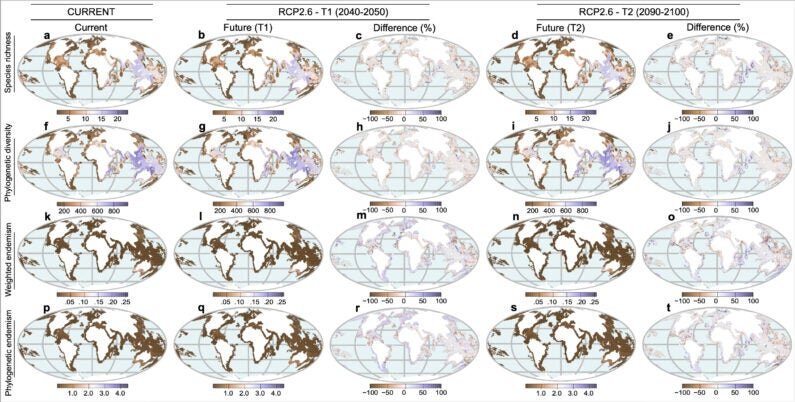11 Dec 2024

Tired Earth
By The Editorial Board

Hidden beneath the waves of coastal waters lies an important member of the marine food chain—seagrasses. These marine meadows are in many ways the unsung heroes of the ocean, benefiting humans and the planet by producing oxygen, removing carbon dioxide from the air, and providing food and habitat for marine life. But these submerged savannahs may be in danger of disappearing, according to a new Stanford study that modeled the distribution of seagrass species around the world at two different timepoints in the future.
Climate change is expected to hit marine species hard, in part because oceans absorb an estimated 80 percent of excess heat from greenhouse gas emissions. Yet it's not fully known how seagrasses will fare in the future, or if the current network of marine protected areas can save seagrasses.
"The simple question we ask in this paper is, 'How will seagrasses—which are a foundational group in the marine food chain—respond to climate change?' " said Barnabas Daru, assistant professor of biology in the Stanford School of Humanities and Sciences.
Seagrasses are an ancient group of plants that originated in the ocean, moved to land, and then returned to the sea roughly 140 million years ago. They provide grazing grounds for herbivores, like endangered green sea turtles, manatees, and parrotfish; they shelter shrimp, marine invertebrates, and fish; and are nurseries for roughly 20 percent of the world's large commercial fisheries.
Many marine organisms depend directly on seagrasses for survival, but many more indirectly benefit from seagrasses.
"For example, sharks feed on marine animals that, in turn, may feed directly or indirectly on plants," said Daru, who is the lead author of the study conducted with Brianna M. Rock, a researcher at Clearwater Marine Aquarium Research Institute in Florida that published June 19 in the journal Nature Plants.
"If anything affects these foundational species at the beginning of the food chain, it will have cascading effects on other organisms that depend on them high up in the food chain, including humans," said Daru.
Modeling seagrasses worldwide
Seagrasses fan out across roughly 116,000 square miles of coastline bordering 191 countries on all continents except Antarctica. Modeling how climate change might affect seagrasses around the world is no small feat.
Daru and Rock began by mapping the location and abundance of each seagrass species using roughly 100 years of seagrass samples collected from coastal ecosystems. They combined these data with records they gathered in the field and information gleaned from public databases of seagrass occurrence, like the Global Biodiversity Information Facility and Seagrass-Watch. They overcame uneven sampling by using data from well-sampled areas, like North America and Europe, to model predicted seagrass habitats for under sampled areas like Southeast Asia and the Indo-Pacific.
Next, they created global "snapshots" representing the ocean's climate today, and how it might be in the time periods of 2040-2050 and 2090-2100 using geophysical and environmental data from the Bio-ORACLE website.
For the present and two future time periods, Daru modeled four different scenarios: a "best-case" climate with low greenhouse gas concentrations; two stabilized scenarios where greenhouse gas levels plateaued; and a "worst-case" scenario with high greenhouse gas concentrations. These modeled scenarios included data on sea temperature, salinity, and sea current speed—all variables known to significantly influence seagrass growth, distribution, and photosynthesis.
Finally, to predict how seagrass populations and distributions might change between the present day and two future timepoints, Daru applied a computer model of the observed species occurrences to each climate scenario.

Saving seagrasses of tomorrow
The study revealed that seagrasses will incur widespread reductions in species diversity and composition with a significant proportion of seagrasses suffering in hotspots that occur outside of the current marine network of marine protected areas. Notably, the researchers found that seagrasses declined in abundance and composition under every scenario they tested, even the "best case" scenario. So what does this mean?
"It probably means that 'the best' is still not enough," Daru said. "We have to be more intentional in how conservation efforts are prioritized and this sort of analysis points to the places where these efforts should be done."
Importantly, the findings of this study also indicate that the current network of marine protected areas is not sufficient.
"One of the signatures of this modern era of profound human impact on the environment is not even the loss of species, but the reorganization of biotic communities. The homogenization of communities is likely to lead to a more profound impact on biodiversity than even the loss of species," Daru said.
When ecosystems become homogenized they lose their distinctiveness and uniqueness, and the decrease in diversity makes them more susceptible to disease and extreme weather events. Such a change could impact both the ecosystem services provided by these communities and the marine life that depends on them. It also may force marine animals that specialize on certain seagrasses to relocate or adapt to less favored seagrass species if their preferred seagrass is lost, which can reduce their fitness and survival.
Despite these sobering findings, the future of seagrasses is far from hopeless.
"We highlighted hotspots of change in species diversity and phylogenetic diversity that represent priority regions to target for conservation efforts," Daru said. "Our goal, our hope is that by pointing policymakers and conservationists to focus on these hotspots, marine protection will be increased in these areas and the future of seagrasses will—to some extent—be safeguarded."
Source : phys.org
Comment